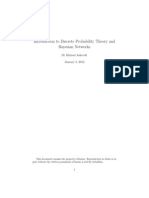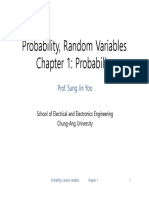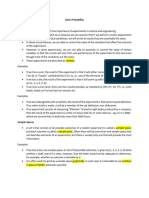0% found this document useful (0 votes)
20 views16 pagesIntroduction of Probability
This document outlines key concepts in probability, including understanding sample spaces and events, calculating probabilities of individual and joint events such as unions and intersections, interpreting and calculating conditional probabilities and determining independence of events. It also introduces probability for discrete sample spaces with a finite number of outcomes and defines probability as a quantification of the likelihood of an outcome occurring, represented by a number between 0 and 1.
Uploaded by
buhbabfCopyright
© © All Rights Reserved
We take content rights seriously. If you suspect this is your content, claim it here.
Available Formats
Download as PPTX, PDF, TXT or read online on Scribd
0% found this document useful (0 votes)
20 views16 pagesIntroduction of Probability
This document outlines key concepts in probability, including understanding sample spaces and events, calculating probabilities of individual and joint events such as unions and intersections, interpreting and calculating conditional probabilities and determining independence of events. It also introduces probability for discrete sample spaces with a finite number of outcomes and defines probability as a quantification of the likelihood of an outcome occurring, represented by a number between 0 and 1.
Uploaded by
buhbabfCopyright
© © All Rights Reserved
We take content rights seriously. If you suspect this is your content, claim it here.
Available Formats
Download as PPTX, PDF, TXT or read online on Scribd
/ 16

























































